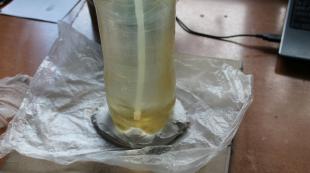Variety of fish. Class bony fish
1. Pisces: diversity, significance in nature and human life.
Fish are the only group of vertebrates that live in an aquatic habitat. They live in both fresh and salt water. Most fish actively swim in the water column and are adapted to living in the aquatic environment. About 25,000 species of fish are known.
Depending on the structural features of the fish are divided into cartilaginous and bone.
TO cartilaginous fish include sharks and rays, their skeleton is cartilaginous. They lack gill covers and swim bladders. They are characterized by live birth. Most are predators, some are dangerous to humans (for example, white sharks).
bony fish subdivided into bone-cartilaginous, lungfish, crossopterous, bony.
TO osteocartilaginous There are 25 species of fish, they are called sturgeons (sturgeon, sterlet, beluga). Their gills are covered with gill covers, there is a swim bladder, an osseous-cartilaginous skeleton. Most of these fish are anadromous: they live in the seas, and go to the rivers for breeding.
Lungfish only 3 species (African flake, American flake, Australian cattail). These fish have lungs in the form of sacs. They are able to breathe atmospheric air during the period of drying of reservoirs (they are buried in silt, a capsule of mucus is formed around the body).
Loop-finned fish represented by only one species - coelacanth. For a long time, these fish were considered extinct. Discovered by accident in 1938. The skeleton of the paired fins of these fish is similar to the five-fingered limb of vertebrates. According to scientists, it was from ancient lobe-finned fish that the first terrestrial vertebrates originated.
bony- the largest group of fish (20,000 species) Have a bone skeleton. Among them are a large number of families (herring, salmon, cyprinids, cod, ...)
The importance of fish in nature and human life is great:
1. Fish are an important link in the food chain for many aquatic organisms.
2. More than 70 million tons of fish are caught annually in reservoirs. Fish is a valuable food product. It contains a large amount of protein, which is easily digestible. The presence of vitamins A and D, phosphorus increases the value of fish as a food product. Along with fishing, artificial breeding of fish in pond farms (carp, trout, silver carp, grass carp) is widely organized.
3. Part of the caught fish is fed to fur-bearing animals.
4. Fish bones are used to make bone meal, which is used in the preparation of pet food.
5. Fish scales are used for the production of glue.
6. Industrial fish oil is obtained from fish production waste, which is used in soap and leather production.
2. Biological community: concept, structural components.
A biological community is an area of the earth's surface with homogeneous components of inanimate nature, on the territory of which live interconnected living organisms live.
Biological communities in biology are called biocenoses. In any biocenosis, three structural components are distinguished:
1. Manufacturers organic matter(producers) - they are represented by plants.
2. Consumers of organic substances (consumers) - they are represented by animals.
3. Destroyers of organic substances (decomposers) - bacteria, mold fungi, soil worms.
Examples of biocenoses: meadow, forest, swamp, lake.
Each biocenosis is characterized by self-regulation. The number of animals and plants at normal conditions remains relatively stable.
Repeat general characteristics and classification of the chordate type.
To study the aromorphoses of the superclass Pisces. Write down in a notebook.
Study the structure of fish. Complete the outline in your notebook.
Record and learn the modern classification of fish.
Consider wet preparations different types fish.
Under the microscope, consider the two main types of bony fish scales.
Explore the outside and internal structure bony bony fish on the example of river perch (opening of the fish).
In the album, complete 6 drawings indicated in the printed manual, which are stored in the laboratory department of biology and ecology, V (red tick). In the electronic training manual, all the drawings necessary for drawing are presented at the end of the entire material.
Draw and fill in table 1 in your notebook:
Table 1. Distinctive features of the organization of fish
classes Cartilaginous fish and Bony fish
|
Class Cartilaginous fish |
Class Bony fish |
|
|
Ordinary Representatives | ||
|
Features of the external structure | ||
|
Features of the internal structure | ||
|
Reproduction features | ||
|
Features of ecology |
Draw and fill in table 2 in your notebook:
Table 2. Diversity of cartilaginous and bony fishes
Know the answers to test questions themes:
General characteristics of the chordate type. Type classification Chordates.
Features of the organization of bone fish.
Systematic position, way of life, body structure, reproduction, significance in nature and for humans River perch.
Distinctive features of the organization of fish classes Cartilaginous fish and Bony fish.
General characteristics of fish
In modern taxonomy of chordates Fishes(Pisces) is a superclass that includes two classes:
Type Chordates (Chordata)
Subtype Vertebrates (Vertebrata)
Superclass Pisces
Class Cartilaginous fish (Chondrichthyes). About 600 species.
Class Bone fish (Osteichthyes). More than 20 thousand species.
Superclass fish has the following aboutmain aromorphoses(Aromorphoses are major evolutionary changes leading to a general complication of the structure and organization of the body):
1. Replacement of the chord with a cartilaginous, then a bone spine.
2. Active search and capture of food (appearance of jaws).
3. The formation of a skull that protects the brain.
4. The emergence of paired limbs - fins.
5. Developed brain and sense organs. The leading part of the brain is the midbrain (the so-called ichthyopsid type of brain).
6. Three semicircular canals appear in the inner ear, lying in mutually perpendicular planes, which ensures better coordination of movements.
7. One circle of blood circulation. The heart is two-chambered. Venous blood in the heart. In lung-breathing fish, the formation of a second, (pulmonary) circle of blood circulation is planned.
8. Olfactory sacs are paired. Each of them opens outwards with an independent nasal passage (paired nostrils).
9. Respiratory organs - gills.
10. digestive tract differentiated: the stomach is separated, the intestine is divided into thin and thick sections.
11. Differentiation of the digestive gland into pancreas and liver.
12. Formation of trunk kidneys (the so-called mesonephric kidney).
13. Protective, mainly bone formations - scales - appear in the skin.
General characteristics of fish
Topic: The variety of fish, their importance in nature. General characteristics of the class. Fish protection. Economic value.
Target: get acquainted with the diversity of fish, the features of their structure and adaptability to life in various conditions, their meaning and protection.
Equipment: multimedia projector, computer, screen
Lesson progress
Ø Organizing time. Greeting students. Checking students' readiness for the lesson.
Ø Motivation and goal setting
“Others got from nature
Instinct prophetically blind -
They smell them, hear the waters...”
Dear friends. Read these words. Who do you think they are dedicated to? Of course, amazing and mysterious animals - fish. Today we will continue to get acquainted with the diversity of representatives of the fish class, with their importance in human life, in nature, and the protection of fish resources. To do this, we will try to solve the following tasks of our communication with you.
Setting lesson objectives with students
Ø Questioning and updating knowledge. Knowledge testing was carried out using 10-point monitoring.
Today we will continue to get acquainted with the diversity of representatives of the fish class, with their significance in nature and in human life.
Fish are the oldest of the vertebrates. The evolutionary age of some of them (sharks, rays, horntooths, African multifeathers, etc.) is very solid - hundreds of millions of years. Therefore, it is not surprising that fish have spread so widely throughout the vast water kingdom from the smallest reservoirs to the great oceans. Among them there are those who dared to go to land. The diversity of habitats provides fish with a wide scope for specialization, the development of a number of adaptations, sometimes very ingenious and most unexpected.
Question. Remember the name of the science that studies fish (ichthyology, a scientist - a specialist who does this - an ichthyologist).
Question. Let's remember the systematic position of fish.
Please …. (call one child) make a systematic position of fish
Right ……………. answers we will check using a multimedia projector
animal kingdom
Subkingdom Multicellular
Type of choral
Subtype Vertebrates
Superclass Pisces
Class Cartilaginous fish
Class Bony fish
Ø Learning new material and partial updating of knowledge.
ü The diversity of fish and their wide distribution in the waters of the oceans.
In the superclass of fish, two classes are distinguished Cartilaginous and Bony fish (slide)
Class characteristic
Cartilaginous fish (700 species)
1. Cartilaginous skeleton throughout life;
2. Head with an elongated snout;
3. Mouth on the underside of the body;
4. 5 pairs of gill slits;
5. The skin is covered with special scales.
Student's speech on the topic "Squads of Sharks and Stingrays"
Bony fish (20 thousand species) One of the numerous and diverse groups of modern fish. Most have a bony skeleton.
Question. What are the reasons for the diversity of bony fish? To answer the question, the children are invited to get acquainted with the biological characteristics of various orders of bony fish.
Acquaintance with the detachments takes place during the performances of students (advanced tasks)
Order Sturgeons.
Spindle-shaped, along the body there are 5 rows of strong bony scales "bug", the location of the mouth on the underside of the head, an uneven fin, gill covers, the preservation of the notochord throughout life. These are valuable commercial fish that provide high-quality meat and black caviar.
Red Book of the Republic of Belarus - Sterlet
Order Herring
Schooling, plankton-eating living along the coast, numerous sticky eggs on the ground or algae. Mainly industrial.
Order Salmonformes
Freshwater and anadromous fish laying a small ring of eggs on the sandy or pebbly bottom of fresh water bodies. A distinctive feature is the adipose fin without bony rays. They give high-quality meat and red caviar.
Order Cyprinidae
Freshwater bony fish that lack jaw teeth have pharyngeal teeth for grinding food. Most commercial fish
Red Book of the Republic of Belarus - common barbel
Squad Crossoptera
An ancient, almost completely extinct group of fish. Currently, only one species of this order is known - coelacanth - living in the depths of the Indian Ocean. It is long m. Its fins are peculiarly arranged - the skeleton of the fin resembles the skeleton of the limbs of terrestrial vertebrates located inside the fleshy blade. The crossopterans represent a special branch from which the ancient amphibians probably originated.
ü General characteristics of the class.
Students compare the studied groups of fish with each other. Find similarities in their structure and give a general description of the class of fish.
1. Aquatic animals (vertebrates)
2.Streamlined body shape
3. Limbs in the form of fins
4. Cartilaginous or bone skeleton
5. Bony fish have a swim bladder
6. Power is active. The alimentary canal is differentiated into sections, there are digestive glands
7. Breathe with gills
8. Closed circulatory system. 1 circle of blood circulation, 2-chambered heart.
9. Organs of excretion - trunk kidneys
10.CNS - neural tube (spinal cord and brain)
11. Well developed: sense of smell, lateral line organs, inner ear, organ of vision adapted for close vision
12. Dioecious animals, external fertilization, development with the larval stage.
OUTPUT: Fish, as aquatic vertebrates with a variable temperature, depend on factors of inanimate nature (temperature, oxygen and carbon dioxide content in water, illumination, etc.). It is the complex relationship of fish with a variety of factors environment underlie their diversity.
ü Economic importance and protection.
Fish and fish products play a significant role in human life. It is one of the main sources of protein, fat and vitamin D (necessary for correct formation bones). Diet product, easy to digest. Fish processing waste is used to make fishmeal (feed additive for agricultural animals) Annually, the world fish catch is 80 million tons. tone. But in recent decades, fish catches have been declining for a number of reasons.
1. Poaching
2. Pollution of water bodies with sewage.
3. Washing off mineral fertilizer fields (water bloom and fish kill)
4. Changing the banks of water bodies (straightening, concreting, building dams, locks, destruction of spawning grounds, unstable water levels, death of eggs)
1.Maintain the frequency of the living environment.
2. The terms and norms for catching fish are established.
3. Fish hatcheries are being built (breeding, fry are released into rivers and the number of fish is restored)
Ø Consolidation.
1. Students are invited to compose features cartilaginous and bony fish classes
2. Students are invited to answer a series of questions
1. By what signs can cartilaginous fish be distinguished from bone fish
2. How is human-caught fish used?
3. What are the reasons for the decrease in the number of fish?
4. A pit was dug and filled with water on the site. Is it possible to put fish in there right away? Justify the answer.
5. What everyone can do without difficulty for themselves in order to save the life of fish and other aquatic animals living in reservoirs
Fish are a class of vertebrates that live in water bodies. Character traits fish:
- Wrap-around shape;
- the presence of a heart with two chambers;
- gills for breathing;
- fins and scales covering the body.
The variety of fish is huge: from small tropical species to sharks weighing 12 tons. Some live in surface waters ocean, others live at a depth of more than 2 km, some are freshwater, others inhabit salt water. These factors influenced the development and evolution of fish, thus shaping the diversity of fish known to man.
Features of the superclass Bony fish
Characteristic features of bony fish:
- Bony or gill covers - cover the gill slits;
- bone skeleton;
- covered with ganoid scales;
- swim bladder;
- sometimes there are lungs;
- fertilization is only external (caviar);
The bony fishes are a diverse group and number 22,000 representatives. Their habitats are all water bodies of the Earth.
Bone detachments and their characteristics

Order Sturgeons. The spine is mostly made up of cartilage, with bones only in the skull. Characteristic for them is the presence of scales (rather thick scales), located in five rows: one on the back, two located on the sides, two in the abdominal region. The head section is elongated, with a small protrusion that helps in finding food at the bottom (different types of invertebrates). They are found in the seas - the Caspian and Black, and during spawning they go to the mouths of the rivers adjacent to them. The largest of the sturgeons is the beluga, whose mass is about 1000 kg.
Order Cyprinidae. Almost all live in fresh water, characterized by the absence of teeth. The disadvantage is compensated by the pharyngeal teeth, which serve to grind food. Carps are carp, bream, catfish, as well as piranhas, etc.
herring. All are marine inhabitants, live in large flocks, feed on small crustaceans. Herring-like species are rounded, flattened from the sides, small gray scales are located on the body. Famous representatives of the order are anchovies, sprats, sprats, etc.
Order Cod. Almost all cod live in the seas, only burbot is freshwater. A distinctive feature of the representatives of the detachment is the presence of a mustache in the chin area. Cod liver is especially valued as a source of vitamin B.
Detachment of the Crossoptera. Science knows only one representative - coelacanth. The body size of the latimetry is about 1.5 m. Found in Indian Ocean. The species disappears within 100 million years and is likely to disappear.
Features of the superclass Cartilaginous
- The skeleton is made up of cartilage;
- there are no covers of gill slits;
- all representatives lack a gill bladder.
Cartilaginous detachments and their characteristics

Shark Squad. All fins (first, second dorsal, pectoral, ventral, caudal) are located horizontally, the caudal fin is especially massive. In the head section there are external gill slits, nostrils, the head has an elongated appearance - the rostrum. Sharks breathe through their mouths, and due to the lack of a swim bladder, they are constantly moving so as not to sink to the bottom.
Fertilization is internal; sharks are characterized by live births or oviposition. Among the sharks, there are both small representatives, only 17 cm long, and a whale shark, 12 meters long. Almost all sharks are predators and are dangerous to humans. Some of them feed only on squid or plankton (largemouth, giant, whale).
Detachment Stingrays. Habitual habitat - the bottom of the sea, their body is flattened in the dorso-abdominal region, flat, in the form of a rhombus. The tail part has changed into a tourniquet. The sizes of stingrays range from 4 cm to large ones, such as the sea devil, with a mass of about 2.5 tons.
Stingrays can use an electric charge (voltage of about 70 W) to protect against enemies, they can kill or paralyze small animals. Large representatives can be dangerous for humans. Like sharks, stingrays are characterized by live birth, they give birth to offspring from 1-3 to 20-25 cubs.
Sections: Biology
Educational:
- reveal the diversity of fish, the features of their adaptation to life in various conditions of the aquatic environment,
- determine the importance of fish in nature and economic human activities,
- the main measures for the protection of fish, to continue the formation of a scientific worldview based on the generalization of knowledge about the structural features of fish.
Developing:
- learn to recognize studied fish,
- be able to compare the structural features of fish,
- be able to work with the textbook,
- observe the rules of fishing and protection of water bodies.
Educational:
- show the influence of the environment and the functioning of fish organs on their structure,
- reveal the relative nature of fitness,
- prove the natural origin of fish,
- introduce the biological foundations, modern achievements, the tasks of fishing and fish farming,
- show the influence of man on the number of fish.
Equipment:
- tables,
- drawings
Form of the lesson: TCO lesson-conference. Computer presentation.
DURING THE CLASSES
1. Organizational moment throughout the lesson.
“Others got from nature
Instinct prophetically blind -
They smell them, hear the waters...”F.I. Tyutchev
Dear friends. Read these words of F.I. Tyutchev. Who do you think they are dedicated to? Of course, amazing and mysterious animals - fish. Today we will continue to get acquainted with the diversity of representatives of the fish class, with their importance in human life, in nature, and the protection of fish resources. To do this, we will try to solve the following tasks of our communication with you. We will conduct our lesson in the form of a conference. To do this, we invited various representatives who are also interested in our tasks, to which they will be able to give more complete answers, as they are experts in this field.
Introducing our guests:
SPECIALISTS:
- Evolutionist,
- Systematist,
- Ichthyologist,
- Ecologist,
- fisheries engineer,
- Chef from the restaurant "Fish Paradise",
- Art critic,
- dietitian,
- Special correspondents of 2 magazines: "Young Naturalist" and "Athlete Fisherman",
- An entertainer fisherman who will participate in the contest "A fisherman sees a fisherman from afar."
And the rest of our audience will listen carefully together with everyone, participate in competitions, and at the end of our conference we will sum up the results. For this you will earn points (fish).
2. Learning new material.
Fish are the oldest of the vertebrates. The evolutionary age of some of them (sharks, rays, horntooths, African multifeathers, etc.) is very solid - hundreds of millions of years. Therefore, it is not surprising that fish have spread so widely throughout the vast water kingdom from the smallest reservoirs to the great oceans. Among them there are those who dared to go to land. The diversity of habitats provides fish with a wide scope for specialization, the development of a number of adaptations, sometimes very ingenious and most unexpected.
The amazing variety of appearance of some fish can amaze the richest imagination. serpentine (eels, moray eels), FLAT (stingrays, flounder), DISC-shaped (fish of the Sunflower family, moonfish), TORPEDO-SHAPED (sharks, tuna), SPHERO-SHAPED (body, fish-ball). They are capable of swimming, crawling, walking and even flying.
Even more incredible is the color of the fish. Often bright and contrasting, it can serve as a means of identifying individuals of its own species or be a warning about the inedibility or toxicity of the host.
What determines the color of fish? Let's ask an ichthyologist about this.
Entertainer fisherman:
But first, tell me the name of the science that studies fish. (Ichthyology. The specialist scientist who does this is an ichthyologist).
Ichthyologist specialist:
The color of the fish is determined by the layer of skin cells under the transparent scales. These flower-bearing cells are called chromatophores and contain grains of pigments, most often orange, yellow and red. They contain both black pigment and guanine crystals, which can give white, silvery and pearlescent iridescent tones. When the last two pigments are combined, the skin acquires magnificent blue and green tints.
Entertainer fisherman:
Let's ask the guys what this coloring of fish is called? (Patronological).
Ichthyologist:
Right! The dark back and white or silver underside make the fish unobtrusive. Bottom fish are very skillfully disguised as the color of the soil. One of the most skilled camouflage masters - common flounder, which with the ease of a chameleon forges its coloring under stones, sand, silt. Sometimes fish reach such perfection that they imitate surrounding objects not only in color, but also in shape. For example, the Amazonian leaf fish surprisingly resembles a browned fallen leaf of a tree. Not inferior to her and the sea rag-picker, merging with the algae in which it lives. In the same intricate way, the Sargassum sea clown is disguised, covered with long skin outgrowths like threads that imitate plant stems.
Thanks for the detailed story.
Tell me, what other signs, in addition to color, are characteristic of fish ? (The shape of the body in which they differ, behavior, lifestyle).
In fact, fish have many features that help them to exist, but all these features are of the relative nature of fitness, as they help them survive in certain conditions of existence; if the conditions of life change, then these adaptations are useless.
We already know that in nature there are a huge number of modern species fish, for this their ancestors went through a very long stage of evolution. What does an evolutionary scientist tell us about this?
Evolutionary Specialist:
First, I would like to ask the guys, what does the term "evolution" mean? It is clear to every biologist that knowledge about the origin and evolution of any living group of organisms is needed not only because “it is interesting”, but also because this knowledge helps to better understand the relationship of modern organisms, the strategy of their adaptation to living conditions. , including the ever-increasing impact of the anthropogenic factor. This knowledge is needed for economically competent formulations and solving problems of rational use resources of modern flora and fauna. Unfortunately, the issues of fish evolution have been studied very poorly.
Allow me to ask a question! What are the reasons for this?
Evolutionary Specialist:
There are several reasons for this, but the main one is the relatively small amount of paleontological material. And the older the fossil remains of fish, the smaller the number of their finds.
Correspondent of the magazine "Young naturalist":
What are the most common finds?
Evolutionary Specialist:
Most often, fossilized teeth, scales and vertebrae of ancient fish are found, less often individual bones of the skull. Finds that are rare and valuable for science are the imprints of a skeleton or even the entire body of a fish. Very rarely found in a petrified state soft tissues animals. For example, the fossilized muscle of a shark that lived more than 300 million years ago was found.
Thanks to evolutionary transformations, the fish flourished. What does a systematic scientist tell us about this issue?
Systematic scientist:
In the process of evolution (over 500 million years), not only did fish and fish species change, but, most importantly, their external and internal structure, physiology, lifestyle changed, various systematic groups of fish appeared, the species of which are about 25 thousand. Let's ask the guys what is the name of the science that classifies organisms into groups according to their degree of relationship? (Systematics). What are the basic systematic units? ( Type-subtype-class-subclass-order-genus-species. Chordata, cranial or vertebrate).
Superclass of fish. Subclass - cartilage and bone.
Shark squad - bone-cartilaginous.
The stingray squad is lungfish.
Cross-finned.
Bony.
Guys, with a textbook at home, fill in the "Systematics of a group of fish."
The similarity of different fish species can be explained either by close kinship (systematization by signs), or by similar features of behavior, lifestyle (biological signs).
Main conclusion:
Diversity of fish - the result life, adaptation to various manifestations of the factors of the aquatic environment, to the main way of life.
So, we got acquainted with the variety of fish, their systematic position. Of no small importance is the practical importance of fish in nature and human life, and, of course, their protection. Let's continue our work. We already know that fish inhabit almost all water bodies, differing in water salinity, oxygen saturation and temperature. With an increase in the depth of water bodies, the force of water pressure increases, illumination decreases, and food conditions become poorer. In the process of historical development, those fish survive that have developed various adaptations to the conditions of life in reservoirs and their parts. The role of fish in nature is very significant due to the diversity of their activities and large numbers.
I see that journalists have already had questions, we give them the floor.
Journalist:
Special correspondent for the magazine "Young Naturalist". My question is for a systematist. Explain why there is such a large variety of fish in the reservoir?
Systematist:
I have already spoken about this issue, but I will continue. Most fish species live in the seas. Marine freshwater species can be found in the water column, bottom layers and at the bottom. Fish that live in the water column and near its surface usually have a streamlined body shape, a highly developed caudal fin. This allows them to swim quickly, escaping from persecution. Bottom swimmers swim slowly, their flattened body is barely noticeable to both prey and enemies. Fish living among bright thickets are brightly colored; in the reservoirs of the caves, in conditions of darkness, colorless fish live. As we have already said, fish can adapt to environmental conditions in different ways, while maintaining their numbers.
The special correspondent of the magazine “Fisher-sportsman” wants to ask his question.
Journalist:
I would like to ask an ecologist a question. What is the importance of fish in nature?
It's no secret that fish eat a large amount of plant and animal food, thereby exerting a significant impact on wildlife. The importance of fish in regulating the abundance of aquatic invertebrates is great. Fish often serve as food for each other and for some birds and mammals.
Thus, fish is an important link in order to feed living organisms.
Entertainer fisherman:
I am a fisherman, and I see a fisherman from afar. Therefore, I propose to cope with the following test: to compose the food chains of the inhabitants of the reservoir.
Journalist's word:
Special correspondent for the magazine "Young Naturalist". Our readers would like to know what is the practical significance of fish for humans.
Who, if not a chef, will answer this question.
Chef:
The importance of fish in human life is exceptionally great: the total world catch of fish per year is approximately 50 million tons. The main value of fish as a food product is in proteins. Fish meat is not inferior in nutritional properties to cattle meat. White fish with lower energy consumption are digested and almost completely absorbed in the gastrointestinal tract. In addition, a fat rich in vitamins, and especially vitamin D, is obtained from fish, which is necessary for both children and adults. Fish is the richest source of vitamins and minerals: K, Na, P, Mg, S, Cl, Fe, I.
Our conversation will be continued by a dietitian.
Dietitian:
Entertainer fisherman:
I am a fisherman, I see a fisherman from afar. Here's your next task: make a menu of three fish dishes.
Leading:
In addition, fish is used for the production of fodder meal for fattening livestock, and fertilizers are made from the waste of the fishing industry. Only an ignorant person thinks that fish and art are things that are not quite compatible, but our art critic thinks differently.
Art critic:
Of course, the fish also ended up on the canvases of artists, for example, still lifes with fish, or A. Matisse's painting “Red Fish”. The names of the fish are imprinted in the names, for example, film. "Meeting place can not be Changed" (hero Karpush), the city of Bychki (Ryazan region), the city of Yelets, the city of Ershov (Saratov region), the city of Sudak, there is Pike Lake, the river Yazva (Perm region), fish is included in the coats of arms of some cities.
- Does it have wings but doesn't fly? (A fish).
- Fighter and bully, lives in the water, claws on the back, and the pike will not swallow. (Ruff).
- He lives in the whirlpool itself, the master of the depths.
He has a deep mouth, and his eyes are slightly visible. (catfish).
There are fish that bear the name of the heavenly bodies - the Moon-fish, the sun-fish.
Agree that the role of fish in human life is invaluable: they are objects of fishing, an integral part of valuable nutrition. Therefore, they must be protected.
The floor is given to a specialist in fish supervision.
Fisheries engineer:
Human impact on the natural environment is constantly growing, as a result, the existence of many species of animals and plants is under the threat of extinction. In our country, a law “On the protection and use of wildlife” has been adopted. A separate chapter on fish requires all fishing institutions and organizations, as well as amateur fishermen, to strictly comply with the established fishing rules. The legislation defines the methods and seasons of fishing. The nets must have cells of at least a certain size so that only adult fish come across in them. It is strictly forbidden to jam fish with explosions, as this would uselessly kill a huge number of fish.
Man reduces and destroys the habitat of fish with his economic activities. We build cities, houses, factories, pollute and drain water bodies - there is no shelter for fish! Unfortunately, more and more species of fish end up on the pages of the Red Book, and man is to blame.
Journalist (special correspondent of the magazine “Young Naturalist”):
I want to ask an environmentalist a question: are there fish on the pages of the Red Book of the Bryansk region that are subject to protection?
8 species of fish are listed in the Red Book of rare and endangered animals of the Bryansk region.
- sterlet (sturgeon),
- common catfish (catfish),
- asp (cyprinids),
- zander,
- ordinary podust,
- sculpin,
- common barbel,
- raw (perch-like).
The number of these species is falling sharply.
Even Robert Burns foresaw the trouble looming over the Pisces class in his poem.
live fast trout in a fast flight
Doomed to run aground, wallow in a swamp.
Alas! Nothing I can help my trout -
She lies on the shore and barely breathes.
Magazine "Angler-sportsman", question:
Who wants to answer this?
Rybnadzor:
I think I can answer this question. Much attention is paid to the issue of treatment facilities, which prevent water contaminated by waste from factories from entering water bodies. In those places where rivers are blocked by dams of power plants, special stepped bypass river routes, as well as elevators, are arranged for migratory fish. In order to increase the number of valuable commercial fish, they are bred in special fish factories, creating favorable conditions for reproduction. (See the diagram of fish development, Fig. 1).
Our conference is coming to an end, we exchanged views and tried to answer many questions. Let's repeat once again what is the importance of fish in nature and human life. To do this, let's look at the diagram:
And now let's sum up the results of the competition "The fisherman sees the fisherman from afar."
3. Conclusion.
Summing up, grading, collecting cards, tokens.
We know a lot about fish
And at the same time little;
And everyone needs: both you and us,
To have more of them!









